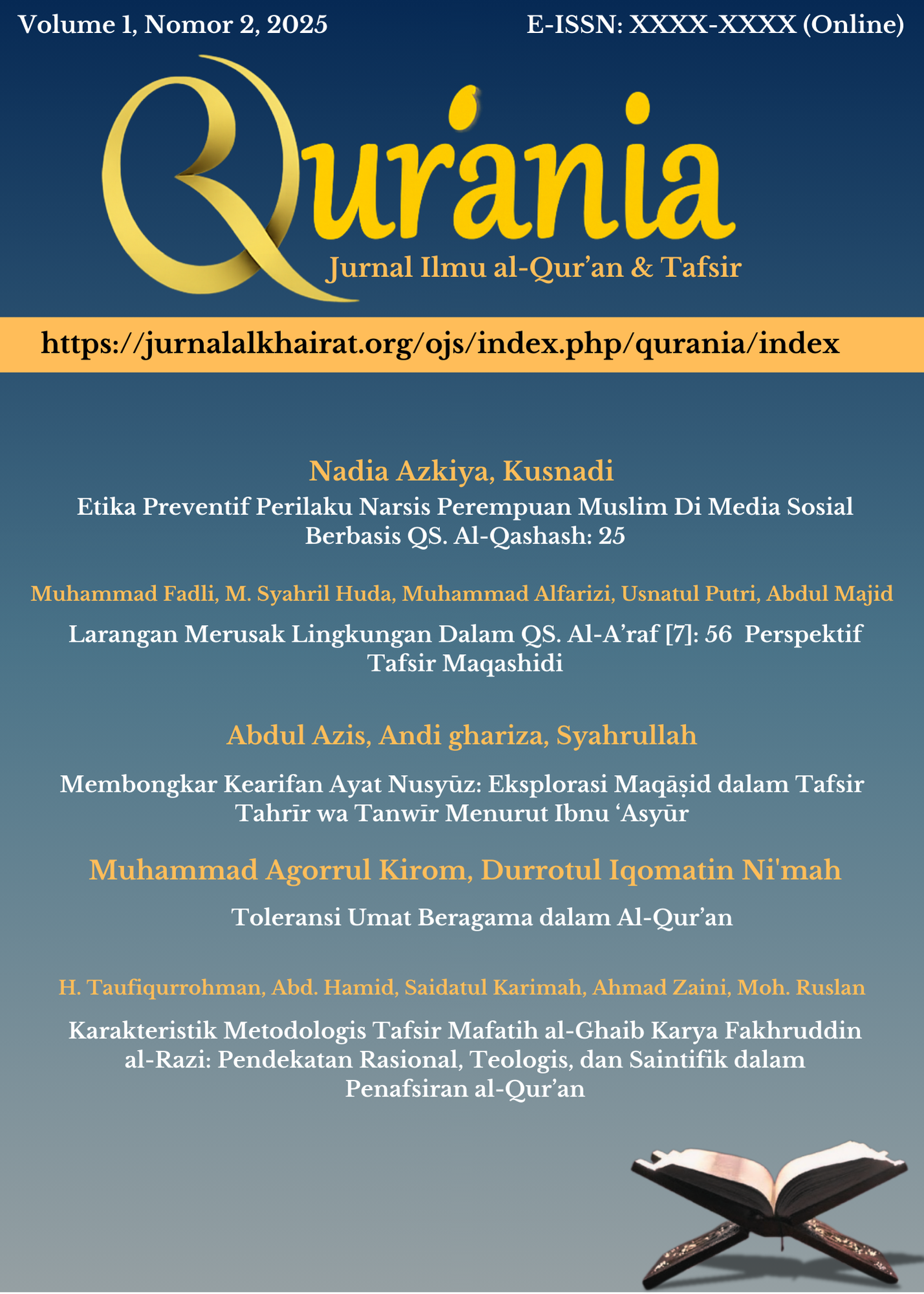Toleransi Umat Beragama dalam Al-Qur’an
Keywords:
Toleransi, Al Qur’an, dan Kebebasan BeragamaAbstract
This study examines the principle of interreligious tolerance from the perspective of the Qur’an. It interprets verses such as Al-Mumtahanah: 8-9, Al-Hujurat: 13, and Al-Baqarah: 256. The aim of this research is to explore the concept of religious tolerance that can serve as an ethical foundation for building harmonious relationships in a pluralistic society. This study employs a qualitative research method in the form of library research. The object of study focuses on the exploration of the concept of religious tolerance based on written sources, particularly the Qur’an and both classical and contemporary tafsir (exegesis) literature. The approach used is a thematic (maudhu’i) interpretation approach, which centers the analysis on a specific theme-eligious tolerance-by compiling several relevant Qur’anic verses and analyzing them comprehensively to obtain a holistic understanding. The analytical method employed is content analysis of the related Qur’anic verses. The findings of this study indicate that differences in faith, ethnicity, and nationality are part of God's will as a means for people to know one another and live side by side. Tolerance in Islam does not imply acknowledging the truth of all religions, but rather maintaining peace and social harmony within the framework of shared humanity. This understanding is highly relevant to be applied in a pluralistic society like Indonesia.
References
Al-Farmawi, Abdul Hayy. Metode Tafsir Maudhu’i: Suatu Pengantar. Jakarta: PT Raja Grafindo Persada. 1994.
Al-Qurthubi. Al Jami’li Ahkam al Qur’an, Juz 7 .Kairo: Dar Al Kutub al-Misriyyah. 1964.
Cecilia, Natasha. “Agama Terbesar di Dunia” https://www.popbela.com/career/inspiration/natasha-cecilia-anandita/agama-terbesar-di-dunia/1,
Hamidullah, Muhamad. The First Written Constitution in the World. Lahore: Sh. Muhammad Ashraf. 1981
Kathir, Ibn. Tafsir al Qur’an al ‘Azhim, Juz 2. Beirut: Dar al kutub al-‘Ilmiyah. 1999.
Krippendorff, Klaus. Content Analysis: An Introduction to Its Methodology. California: Sage Publications. 2013.
Murni, Dewi. ‘’Toleransi dan kebebasan beragama dalam persfektif Al-Qur’an’’, Jurnal Syahadah Vol. 1 , No 2. 2019.
Shihab, M. Quraish. Membumikan Al Qur’an: Fungsi dan Peran Wahyu dalam Kehidupan Masyarakat. Bandung: Mizan. 2013.
Sukardja, Ahmad. Piagam Madinah dan Undang-Undang Dasar 1945: Kajian Perbandingan Tentang Dasar Hidup Bersama dalam Masyarakat yang Majemuk. Jakarta: UI Press. 1995.
Suyuthi, Imam.’’Lubab An-Nuqul Fi ‘Asbabab An-nuzul’’. Beirut : Dar Al-Kotob Al Ilmiyah. 2020.
Zamawi, Baharudin., Bullah, Habieb., dan Zubaidah. ‘’Ayat Toleransi dalam Al-Qur’an’’, Dhiya Al-Afkar Volume.1 , No. 7. 2019.
Zed, Mestika. Metode Penelitian Kepustakaan. Jakarta: Yayasan Obor Indonesia. 2008.
Additional Files
Published
How to Cite
Issue
Section
License
Copyright (c) 2025 Muhammad Agorrul Kirom, Durrotul Iqomatin Ni'mah

This work is licensed under a Creative Commons Attribution-NonCommercial-ShareAlike 4.0 International License.
License
Qur'ania: Jurnal Ilmu al-Qur'an dan Tafsir is licensed under a Creative Commons Attribution- 4.0 International Public License (CC - BY 4.0).








